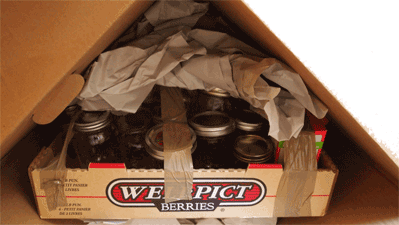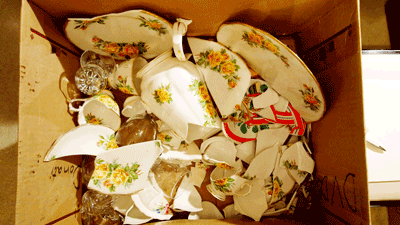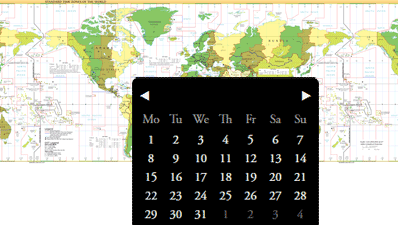Types of Move Packing
![]() Professional move packing services bring an understanding of the trip your possessions will take, assuring they are packed for those demands, without costing you needless extra.
Professional move packing services bring an understanding of the trip your possessions will take, assuring they are packed for those demands, without costing you needless extra.
![]() Professionals work is based on the different priorities each type of move packing requires.
Professionals work is based on the different priorities each type of move packing requires.
Five basic packing types are:
- Local move packing
- National move packing
- International move packing
- Special packing services
- Packing for storage
![]() Local move packing: Local moves feature minimal handling with the shortest pack unpack cycle. Local move packers pack and pad possessions directly into the moving van. The next day they unpack at the destination.
Local move packing: Local moves feature minimal handling with the shortest pack unpack cycle. Local move packers pack and pad possessions directly into the moving van. The next day they unpack at the destination.
![]() National move packing: National domestic moves need extended handling. Shipping across climate zones, the local pick up van transferred to truck or train containers and storage coordination are extra to what local moves include.
National move packing: National domestic moves need extended handling. Shipping across climate zones, the local pick up van transferred to truck or train containers and storage coordination are extra to what local moves include.
![]() International move packing: International moves include more handling and storage. Transfer from truck to train, plane, ship and customs also adds storage and processing. Storage that avoids freezing or excessive heat damage. Wooden antiques and lacquer finished furniture tend to be easily damaged these ways. Packing and crating with plastic wrap protection from dust and insects is an option sometimes also used.
International move packing: International moves include more handling and storage. Transfer from truck to train, plane, ship and customs also adds storage and processing. Storage that avoids freezing or excessive heat damage. Wooden antiques and lacquer finished furniture tend to be easily damaged these ways. Packing and crating with plastic wrap protection from dust and insects is an option sometimes also used.![]() Special packing services: Piano’s, antiques, safes, vehicles are all items that need unique packing or crating. Item specialists are used specifically for handling these.
Special packing services: Piano’s, antiques, safes, vehicles are all items that need unique packing or crating. Item specialists are used specifically for handling these.
![]() Packing for storage: Moving items into storage is about the expected duration and any need for interim access. A stable, clean controlled environment supports proper packing. Structural crating, even in Furniture Vaults often secures items more conveniently.
Packing for storage: Moving items into storage is about the expected duration and any need for interim access. A stable, clean controlled environment supports proper packing. Structural crating, even in Furniture Vaults often secures items more conveniently.
Golden Packing Rules for International Moves
Eliminate items not practical to pack.
• Plants, Perishables, Dangerous Goods, Chemicals are first on the list of items to leave behind. The risks of damaging other items, triggering a detailed customs inspection never mind the costs in time and money to pack and ship are needlessly high. Even a small missed item included in the shipment can cause extra days of inspection and storage in customs resulting in thousands if not tens of thousands of dollars in customs handling charges.
• Dangerous Goods impact shipping policies and import restrictions for controlled flammable items, alcohol and most chemicals used to care for your home inside and out.

• Professional packers are obligate to pack what you leave to be packed, even the empty Mason jars, on that top shelf or plants that won’t be watered till arrival.
• Often larger furniture, that fits Canadian homes, won’t work in smaller room sizes typical in many other countries.
• Donation or sell off items no longer needed or that will be less expensive to replace at your destination.
Identify items for special packing attention.
• Personal: medications, special papers, school records, clothing and emergency contact numbers should be brought with you while traveling.
• First use items: these are the items you will need to have unpacked first … bedding, clothes, food preparation items and tools tend to be in this group. Identify them for specially marked packing so they easily become identified on arrival.
• Fragile and personal joy items that mean much to you also benefit from special attention of internal packing, without special external indication that might draw unwanted risks.
Packing supplies.
• The strongest boxes you are able to obtain are the best choice for international moves. Many smaller sizes of those boxes will help to fill shipping containers both more completely and more securely. Boxes showing the words TOP and BOTTOM clearly so reflect how they are packed.
• Use bubble wrap and styrofoam pellets to protect your fragile items. The weight of the shipment stays with your goods instead of BEING wasted on heavy padding material. The packing materials used need to be able to withstand more than the single handling afternoon drive and unloading which a local move entails. Wrapping avoids scratches and wearing but also needs to be resilient enough for constant weight and jostling pressures.
• Securely taping all seems on each box is especially important with international moves. The tapping secures the box square strength and alignment, maintaining support when stacked with the other boxes. Transit through coordinated shipments and storage facilities exposes packing to potentially added handling risks, contaminants and inspections that complete taping can protect from. In some cases, complete plasticizing is another option.
Arrange items for each packed box.
• The heaviest items belong on the bottom of the box. Heavy books and strongly structured items first. Pack smaller items around the sides wrapped in bubble wrap. Pack lighter items towards the top of the box. Wrapping glass in bubble wrap is intuitive, but how it gets positioned in the box is not as simple and yet just as important. Each box being filled to the top helps the box protect the goods inside as strongly as possible.

• Remember those dishes of your mothers packed and already in storage. International moves are about dealing with transit and transfers rather than sitting still in storage. Shipping as is, ends in many tears at the sight of broken plates and lost memories. Professional international move packers know to REPACK all items already packed.
• Pack boxes by room… that is for rooms at your destination. You will setup your new home more quickly and easily when you do not have to move boxes and items from room to room. Labeling the boxes based on what the contents are is not as secure as labeling by destination room. Labeling the boxes helps the customs and importation process as well.
• Pack everything into boxes. Avoid putting extra pressures on existing drawers and containers, resulting in needless handling damage.
• Furniture purchased in knocked down packaging is best disassembled and knocked down, just as it was shipped to you. Particle board joints and press board furniture are not strong enough, once assembled, to handle shipping.
About the move…

• Picture yourself moved in… at that new time zone and on that future date. Work you way back from today through the steps including movers arriving, unpacking. The tree of activity along the path.
• Insurance is a consideration that addresses items that can be repaired or repurchased. While not all you possessions will fit a repair or replacement option, the care and attention to proper packing complete with the time that work takes is a realistic place to start from. It is also why international shipping insurance only applies to items packed by the moving company for that specific move.
• International moving means your possessions will face predictable handling of shipment transfers. Your belongings will face exposure to things like the cargo ship rocking 20 degrees, dust, smells and insects. They will be packed, unpacked and reloaded, at the very least by customs at their destination country. Proper packing is in your control to mitigate risks. Issues Bekins Professional Packers know and deal with daily.
What To Pack – Packing Box Size
![]() When moving internationally there are considerations beyond what will fit in the box that include:
When moving internationally there are considerations beyond what will fit in the box that include:
• What part of the shipment costs come from weight and what part come from the cubic feet involved?
• What are the handling costs and dangers involved in the complexity of loading of the boxes into, and then out of each shipping and storage component of the move?
• What are the environment implications of the weather and time the trip to the destination will take?
• What are the customs and clearing implications to the processing of the shipment of household goods?![]() As a rule more small boxes speed up the handling and reduce the risks of damage. Crating however does not follow this generalization.
As a rule more small boxes speed up the handling and reduce the risks of damage. Crating however does not follow this generalization.![]() Guidelines for the use of sturdy packing boxes that are taped using strong packing tape with the flaps joined and matching each other are:
Guidelines for the use of sturdy packing boxes that are taped using strong packing tape with the flaps joined and matching each other are:
• Small boxes (1 cu ft, 12x12x12 and 1.5 cu ft, 12x12x16) packed weight to 62lbs. For books, records, cds, video recordings, tools, canned food, dense heavy items.
• Medium boxes (2 cu ft, 18x15x12.5 and 3.0 cu ft, 18x18x16) packed weight to 60lbs. For appliances, cooking utensils, dishes, kitchen goods, breakables, shoes, games moderately heavy items.
• Large boxes (4 cu ft, 18x18x21, 5.0 cu ft, 18x18x26.5 and 6.0 cu ft, 20x20x26) packed weight to 65lbs. For cloths, linens, toys, pots, pans, some light small appliances and items considered as light items.
• Wardrobe Cartons (13x20x48 in) packed weight to 100lbs. Metal hanging bars in these type of cartons help your move hanging cloths and drapes.![]() Typically they can be packed tighter than a normal closet and allow bulky light items like pillows to fill open spaces.
Typically they can be packed tighter than a normal closet and allow bulky light items like pillows to fill open spaces.
• Lampshade Cartons (20x20x20) are for very light weight bulky items, like lamp shades, which require individual protected packing.
• Small Mirror Carton (37×4.3×26.5) for mirrors, pictures and flat potentially fragile objects that benefit from extra protection. For very light weight bulky items, like lamp shades, which require individual protected packing.
• Large Mirror Carton (48×4.3×32.5) for mirrors, pictures and flat potentially fragile objects that benefit from extra protection.
• Specialty Packing Boxes and Crates for hard to pack or unique items … everything from pianos or tv’s that no longer have their original packing to antique cars that require support structures
• Countries vary in restrictions. When packed containers are required to undergo certified container fumigation packing challenges and shipping days are added. Certified & stamped lumber for crating is another additional issue.
